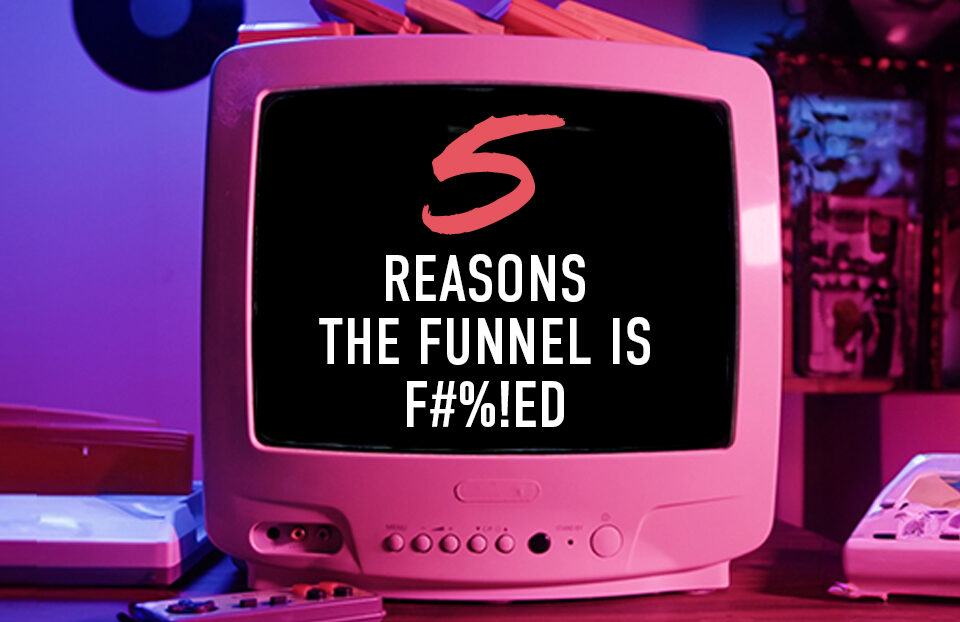

Posted In: Strategy by
Jenn Ferrier,
August 17, 2023

5 Reasons Why The Funnel is F#%!ed
Sophie Cork , Boutiques’ DISCOtiquer and Senior Planner
This is the first of our F#%! The Funnel series, outlining our alternative approach to the AIDA funnel and we, as a strategy-driven channel agency, came up with something better.
As longstanding and widely-used as it may still be, we’ve moved from the traditional marketing funnel at Boutique. And so should you. Let’s start by recapping the reasons why we think the funnel falls short.
It’s too simplistic
One of the most common criticisms of the AIDA funnel is that it assumes an overly-simplified progression of consumer behaviour; to expect that consumers simply go from becoming aware of the existence of a brand, to considering them, then buying, makes an often very complex and drawn-out decision making process a cold, and linear one.
More often than not, we’ll be thinking about a few different brands at once and we’ll revisit stages of consideration, exploration and evaluation many times over with different brands in mind, weighing them up against each other and testing them against our needs. Oversimplfying the customer buying journey can lead brands to totally overlook the importance of the complexities of consumer mindset when thinking about how to ultimately win share.
It underplays the importance of brand assimilation
In positioning ‘Awareness’ as the first stage, it assumes that once attention is grabbed at the start of the journey then naturally consumers will follow with interest and desire if the work is done. However, building and maintaining not just brand awareness, but brand assimilation, is a critical aspect of long-term success.
Brand awareness refers to the extent that consumers are familiar with a particular brand and covers both recognition and recall – the ability to retrieve a brand from memory or to what extent the brand is front of mind. Brand assimilation on the other hand goes beyond awareness and focuses instead on the degree in which the brand is integrated within a consumer’s belief system. Brands who have established strong assimilation have successfully communicated their values and have built strong meaningful connections with consumers. This requires a higher level of engagement and alignment of values, and is how brands achieve long-term customer retention and loyalty.
It overlooks post-purchase
By having the sale or action as the destination, the funnel provides a model which is concerned only with the acquisition of new customers and getting conversions, neglecting the crucial stages of customer retention and advocacy building which brands rely on for long-term growth.
It doesn’t give us a framework for understanding the importance of what happens around a purchase – what experience do consumers have post-purchase and how can that influence their overall experience of that brand? And what work do brands need to do to ensure customers buy again, become loyal or become advocates?
Brands without a clear path to this vital stage of customer behaviour and decision making are at risk of losing their customers to brands who do.
It doesn’t consider emotions
The funnel predominantly focuses on the rational aspects of customer decision-making while overlooking the importance of the emotional factors which arguably influence purchase behaviour more – particularly when it comes to large-ticket items or trading up to pricier brands.
Through the decision making process, at the same time as we’re considering practical factors typically focussed around the rational (eg. price, quality, product specification), we’ll be unconsciously asking ourselves questions like, can I see myself owning something from this brand? Do people like me own things from this brand? And what does this brand offer me that this other brand doesn’t? These are all concerned with the emotional connection we have with brands and involve emotion-led evaluations like trust, empathy and personal affinity, all overlooked by the traditional funnel.
It was created in a pre-digital world
Sources cite the AIDA funnel back to 1925 with its roots going back as early as 1898 – well before the emergence of digital and at a time when only a few select traditional media channels existed. Digital channels, social media, influencers and content marketing all transformed the landscape of advertising, and yet the funnel’s structure remains untouched.
This new online landscape is highly competitive for brands fighting for consumer attention. Fragmented attention spans from consumers bombarded with advertising online makes it harder to be heard more than ever, and the funnel’s fixed sequential stages doesn’t provide a framework for brands to win attention, build connections and steal share in the fast-paced decision making online marketplace. It also overlooks the importance of the interactive nature of digital channels; consumers now have greater access to brands and are able to build personal relationships with them through social media, online communities and UGC, but the importance of this participatory dynamic for brands isn’t accounted for.
At best, the traditional marketing funnel is outdated and reductive, at worst it can hold brands back from long-term success. The funnel tells us nothing about the process that buyers go through when they make choices and, in a world where there are more choices than ever before, advertisers need to have a clear strategy as to how they’ll cut through the noise. As consumers weigh up different options, it’s imperative that brands understand what consumers are looking for and how they can be sure they’re the right choice.
Stay tuned for our next piece in this content series on our alternative to the traditional funnel which takes into account the challenges discussed in this first part.
—
Feeling fired up after reading that and wanna talk?
Get in touch @ hello@weareboutique.co.uk for chat and a cuppa.